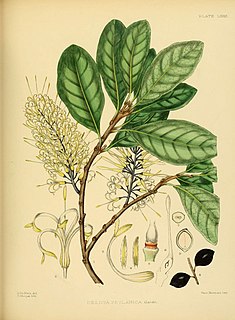
Endoclita is a genus of moths of the family Hepialidae. There are 60 described species found in eastern and southeast Asia and the Indian subcontinent.

Kemp's gerbil is a species of rodent. Mammal Species of the World considers G. kempi and G. gambianus to be synonyms, however the IUCN has assessed each taxon as were they different species.
Byttneria asplundii is a species of flowering plant in the family Malvaceae. It is found only in Ecuador. Its natural habitats are subtropical or tropical dry forests, subtropical or tropical moist lowland forests, and subtropical or tropical moist montane forests.

Byttneria is a genus of flowering plants in the family Malvaceae. There are about 135 species in this pantropical genus.
Byttneria flexuosa is a species of flowering plant in the family Malvaceae. It is found only in Ecuador. Its natural habitat is subtropical or tropical moist montane forests.
Byttneria ivorensis is a tree in the family Malvaceae that is now classified as extinct. It was identified from a single herbarium specimen collected in the Upper Guinean forests of Ivory Coast.
Byttneria jaramilloana is a species of flowering plant in the family Malvaceae. It is found only in Ecuador. Its natural habitats are subtropical or tropical moist montane forests, subtropical or tropical dry shrubland, and subtropical or tropical high-altitude shrubland.
Byttneria loxensis is a species of flowering plant in the family Malvaceae. It is found only in Ecuador. Its natural habitat is subtropical or tropical dry shrubland.
Byttneria minytricha is a species of flowering plant in the family Malvaceae. It is found only in Ecuador. Its natural habitat is subtropical or tropical moist montane forests.
Byttneria obtusata is a species of flowering plant in the family Malvaceae. It is found only in Ecuador. Its natural habitat is subtropical or tropical moist montane forests.
Joseanthus sparrei is a species of flowering plant in the family Asteraceae. It is found only in Ecuador. Its natural habitat is subtropical or tropical moist montane forests. It is threatened by habitat loss.
Asplundia sparrai is a species of plant in the Cyclanthaceae family. It is endemic to Ecuador. Its natural habitat is subtropical or tropical moist montane forests.

Helicia is a genus of 110 species of trees and shrubs, constituting part of the plant family Proteaceae. They grow naturally in rainforests throughout tropical South and Southeast Asia, including India, Sri Lanka, Indochina, Peninsular Malaysia to New Guinea and as far south as New South Wales.
Lysipomia sparrei is a species of plant in the family Campanulaceae. It is endemic to Ecuador. Its natural habitats are subtropical or tropical high-altitude shrubland and subtropical or tropical high-altitude grassland. It is threatened by habitat loss.
Miconia sparrei is a species of plant in the family Melastomataceae. It is endemic to Ecuador.
Ossaea sparrei is a species of plant in the family Melastomataceae. It is endemic to Ecuador.

The World's 25 Most Endangered Primates is a list of highly endangered primate species selected and published by the International Union for Conservation of Nature (IUCN) Species Survival Commission (SSC) Primate Specialist Group (PSG), the International Primatological Society (IPS), Global Wildlife Conservation (GWC), and Bristol Zoological Society (BZS). The IUCN/SSC PSG worked with Conservation International (CI) to start the list in 2000, but in 2002, during the 19th Congress of the International Primatological Society, primatologists reviewed and debated the list, resulting in the 2002–2004 revision and the endorsement of the IPS. The publication was a joint project between the three conservation organizations until the 2012–2014 list when BZS was added as a publisher. The 2018–2020 list was the first time Conservation International was not among the publishers, replaced instead by GWC. The list has been revised every two years following the biannual Congress of the IPS. Starting with the 2004–2006 report, the title changed to "Primates in Peril: The World's 25 Most Endangered Primates". That same year, the list began to provide information about each species, including their conservation status and the threats they face in the wild. The species text is written in collaboration with experts from the field, with 60 people contributing to the 2006–2008 report and 85 people contributing to the 2008–2010 report. The 2004–2006 and 2006–2008 reports were published in the IUCN/SSC PSG journal Primate Conservation,, since then they have been published as independent publications.
Endoclita undulifer is a species of moth of the family Hepialidae. It is known from India. Food plants for this species include Alnus, Byttneria, Callicarpa, Cryptomeria, Eucalyptus, and Gmelina.





